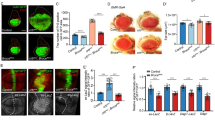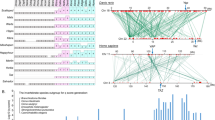Abstract
The Hippo signaling network is proving to be an essential regulator within the cell, participating in multiple cellular phenotypes including cell proliferation, apoptosis, cell migration and organ size control. Much of this pathway is conserved from flies to mammals; however, how the upstream components, namely Expanded, affect downstream processes in mammalian systems has remained elusive. Only recently has human Expanded (hEx), also known as FRMD6 or Willin, been identified. However, its functional significance with respect to its putative tumor suppressor function and activation of the Hippo pathway has not been studied. In this study, we show for the first time that hEx possesses several tumor suppressor properties. First, hEx dramatically inhibits cell proliferation in two human cancer cell lines, MDA-MB-231 and MDA-MB-436 cells, and sensitizes these cells to the chemotherapeutic drug Taxol. Furthermore, downregulation of hEx in the immortalized MCF10A breast cell line leads to enhanced proliferation and resistance to Taxol treatment. As evidence for its tumor suppressor function, overexpression of hEx inhibits colony formation, soft agar colony growth in vitro and in vivo tumor growth in nude mice. Although Drosophila expanded (ex) can activate the Hippo pathway, surprisingly no significant alterations were discovered in the phosphorylation status of any of the Hippo pathway components, including downstream tumor suppressor LATS1, upon overexpression of hEx. In addition, knockdown of both LATS1 and LATS2 in hEx-overexpressing cells was unable to rescue the hEx phenotype, suggesting that hEx functions independently of the Hippo pathway in this cell line. Alternatively, we propose a mechanism through which hEx inhibits progression through the S phase of the cell cycle by upregulating p21Cip1 and downregulating Cyclin A. This is the first study to functionally characterize hEx and show that hEx acts in a distinct manner compared with Drosophila expanded.
This is a preview of subscription content, access via your institution
Access options
Subscribe to this journal
Receive 50 print issues and online access
$259.00 per year
only $5.18 per issue
Buy this article
- Purchase on Springer Link
- Instant access to full article PDF
Prices may be subject to local taxes which are calculated during checkout




Similar content being viewed by others
References
Badouel C, Gardano L, Amin N, Garg A, Rosenfeld R, Le Bihan T et al. (2009). The FERM-domain protein expanded regulates hippo pathway activity via direct interactions with the transcriptional activator yorkie. Dev Cell 16: 411–420.
Blaumueller CM, Mlodzik M . (2000). The drosophila tumor suppressor expanded regulates growth, apoptosis, and patterning during development. Mech Dev 92: 251–262.
Boedigheimer M, Laughon A . (1993). Expanded: a gene involved in the control of cell proliferation in imaginal discs. Development 118: 1291–1301.
Boedigheimer MJ, Nguyen KP, Bryant PJ . (1997). Expanded functions in the apical cell domain to regulate the growth rate of imaginal discs. Dev Genet 20: 103–110.
Chan EH, Nousiainen M, Chalamalasetty RB, Schafer A, Nigg EA, Sillje HH . (2005). The Ste20-like kinase Mst2 activates the human large tumor suppressor kinase Lats1. Oncogene 24: 2076–2086.
Chan SW, Lim CJ, Guo K, Ng CP, Lee I, Hunziker W et al. (2008). A role for TAZ in migration, invasion, and tumorigenesis of breast cancer cells. Cancer Res 68: 2592–2598.
Feng Y, Irvine KD . (2007). Fat and expanded act in parallel to regulate growth through warts. Proc Natl Acad Sci USA 104: 20362–20367.
Genevet A, Wehr MC, Brain R, Thompson BJ, Tapon N . (2010). Kibra is a regulator of the Salvador/Warts/Hippo signaling network. Dev Cell 18: 300–308.
Gunn-Moore FJ, Welsh GI, Herron LR, Brannigan F, Venkateswarlu K, Gillespie S et al. (2005). A novel 4.1 ezrin radixin moesin (FERM)-containing protein, ‘willin’. FEBS Lett 579: 5089–5094.
Guo C, Tommasi S, Liu L, Yee JK, Dammann R, Pfeifer GP . (2007). RASSF1A is part of a complex similar to the drosophila Hippo/Salvador/Lats tumor-suppressor network. Curr Biol 17: 700–705.
Halder G, Johnson RL . (2011). Hippo signaling: growth control and beyond. Development 138: 9–22.
Hamaratoglu F, Willecke M, Kango-Singh M, Nolo R, Hyun E, Tao C et al. (2006). The tumour-suppressor genes NF2/Merlin and expanded act through hippo signalling to regulate cell proliferation and apoptosis. Nat Cell Biol 8: 27–36.
Hanahan D, Weinberg RA . (2011). Hallmarks of cancer: the next generation. Cell 144: 646–674.
Hao Y, Chun A, Cheung K, Rashidi B, Yang X . (2008). Tumor suppressor LATS1 is a negative regulator of oncogene YAP. J Biol Chem 283: 5496–5509.
Jung YS, Qian Y, Chen X . (2010). Examination of the expanding pathways for the regulation of p21 expression and activity. Cell Signal 22: 1003–1012.
Lai D, Ho KC, Hao Y, Yang X . (2011). Taxol resistance in breast cancer cells is mediated by the hippo pathway component TAZ and its downstream transcriptional targets Cyr61 and CTGF. Cancer Res 71: 2728–2738.
Lau YK, Murray LB, Houshmandi SS, Xu Y, Gutmann DH, Yu Q . (2008). Merlin is a potent inhibitor of glioma growth. Cancer Res 68: 5733–5742.
Lei QY, Zhang H, Zhao B, Zha ZY, Bai F, Pei XH et al. (2008). TAZ promotes cell proliferation and epithelial-mesenchymal transition and is inhibited by the hippo pathway. Mol Cell Biol 28: 2426–2436.
Li W, Wang L, Katoh H, Liu R, Zheng P, Liu Y . (2011). Identification of a tumor suppressor relay between the FOXP3 and the hippo pathways in breast and prostate cancers. Cancer Res 71: 2162–2171.
Li Y, Pei J, Xia H, Ke H, Wang H, Tao W . (2003). Lats2, a putative tumor suppressor, inhibits G1/S transition. Oncogene 22: 4398–4405.
McCartney BM, Kulikauskas RM, LaJeunesse DR, Fehon RG . (2000). The neurofibromatosis-2 homologue, merlin, and the tumor suppressor expanded function together in drosophila to regulate cell proliferation and differentiation. Development 127: 1315–1324.
McGrogan BT, Gilmartin B, Carney DN, McCann A . (2008). Taxanes, microtubules and chemoresistant breast cancer. Biochim Biophys Acta 1785: 96–132.
Ogryzko VV, Wong P, Howard BH . (1997). WAF1 retards S-phase progression primarily by inhibition of cyclin-dependent kinases. Mol Cell Biol 17: 4877–4882.
Ota M, Sasaki H . (2008). Mammalian Tead proteins regulate cell proliferation and contact inhibition as transcriptional mediators of hippo signaling. Development 135: 4059–4069.
Pan D . (2010). The hippo signaling pathway in development and cancer. Dev Cell 19: 491–505.
Pellock BJ, Buff E, White K, Hariharan IK . (2007). The drosophila tumor suppressors expanded and merlin differentially regulate cell cycle exit, apoptosis, and wingless signaling. Dev Biol 304: 102–115.
Polesello C, Huelsmann S, Brown NH, Tapon N . (2006). The drosophila RASSF homolog antagonizes the hippo pathway. Curr Biol 16: 2459–2465.
Radu M, Chernoff J . (2009). The DeMSTification of mammalian Ste20 kinases. Curr Biol 19: R421–R425.
Stern C, Bridges CB . (1926). The mutants of the extreme left end of the second chromosome of DROSOPHILA MELANOGASTER. Genetics 11: 503–530.
Visser S, Yang X . (2010a). Identification of LATS transcriptional targets in HeLa cells using whole human genome oligonucleotide microarray. Gene 449: 22–29.
Visser S, Yang X . (2010b). LATS tumor suppressor: a new governor of cellular homeostasis. Cell Cycle 9: 3892–3903.
Xia H, Qi H, Li Y, Pei J, Barton J, Blackstad M et al. (2002). LATS1 tumor suppressor regulates G2/M transition and apoptosis. Oncogene 21: 1233–1241.
Xiao L, Chen Y, Ji M, Dong J . (2011). KIBRA regulates hippo signaling activity via interactions with large tumor suppressor kinases. J Biol Chem 286: 7788–7796.
Yang X, Li DM, Chen W, Xu T . (2001). Human homologue of drosophila lats, LATS1, negatively regulate growth by inducing G(2)/M arrest or apoptosis. Oncogene 20: 6516–6523.
Yu J, Zheng Y, Dong J, Klusza S, Deng WM, Pan D . (2010). Kibra functions as a tumor suppressor protein that regulates hippo signaling in conjunction with merlin and expanded. Dev Cell 18: 288–299.
Zhao B, Li L, Lei Q, Guan KL . (2010). The hippo-YAP pathway in organ size control and tumorigenesis: an updated version. Genes Dev 24: 862–874.
Zhao B, Ye X, Yu J, Li L, Li W, Li S et al. (2008). TEAD mediates YAP-dependent gene induction and growth control. Genes Dev 22: 1962–1971.
Acknowledgements
This work was supported by a grant from the Canadian Institute of Health Research, a New Investigator Award from the Canadian Institute of Health Research and an Early Researcher Award from the Ontario Ministry of Research and Innovation, Canada, to Xiaolong Yang; and an Ontario Graduate Scholarship to Stacy Visser-Grieve. We would like to thank Matt Gordon at the Queen's Cancer Research Institute for performing the FACS analysis and Dr Frank Gunn-Moore for providing the hEx-GFP plasmid.
Author information
Authors and Affiliations
Corresponding author
Ethics declarations
Competing interests
The authors declare no conflict of interest.
Additional information
Supplementary Information accompanies the paper on the Oncogene website
Rights and permissions
About this article
Cite this article
Visser-Grieve, S., Hao, Y. & Yang, X. Human homolog of Drosophila expanded, hEx, functions as a putative tumor suppressor in human cancer cell lines independently of the Hippo pathway. Oncogene 31, 1189–1195 (2012). https://doi.org/10.1038/onc.2011.318
Received:
Revised:
Accepted:
Published:
Issue Date:
DOI: https://doi.org/10.1038/onc.2011.318
Keywords
This article is cited by
-
FERM domain-containing protein FRMD6 activates the mTOR signaling pathway and promotes lung cancer progression
Frontiers of Medicine (2023)
-
FRMD6 has tumor suppressor functions in prostate cancer
Oncogene (2021)
-
Expression and regulation of FRMD6 in mouse DRG neurons and spinal cord after nerve injury
Scientific Reports (2020)
-
Tumor suppressor genes and their underlying interactions in paclitaxel resistance in cancer therapy
Cancer Cell International (2016)
-
Oncogenic role of Merlin/NF2 in glioblastoma
Oncogene (2015)



